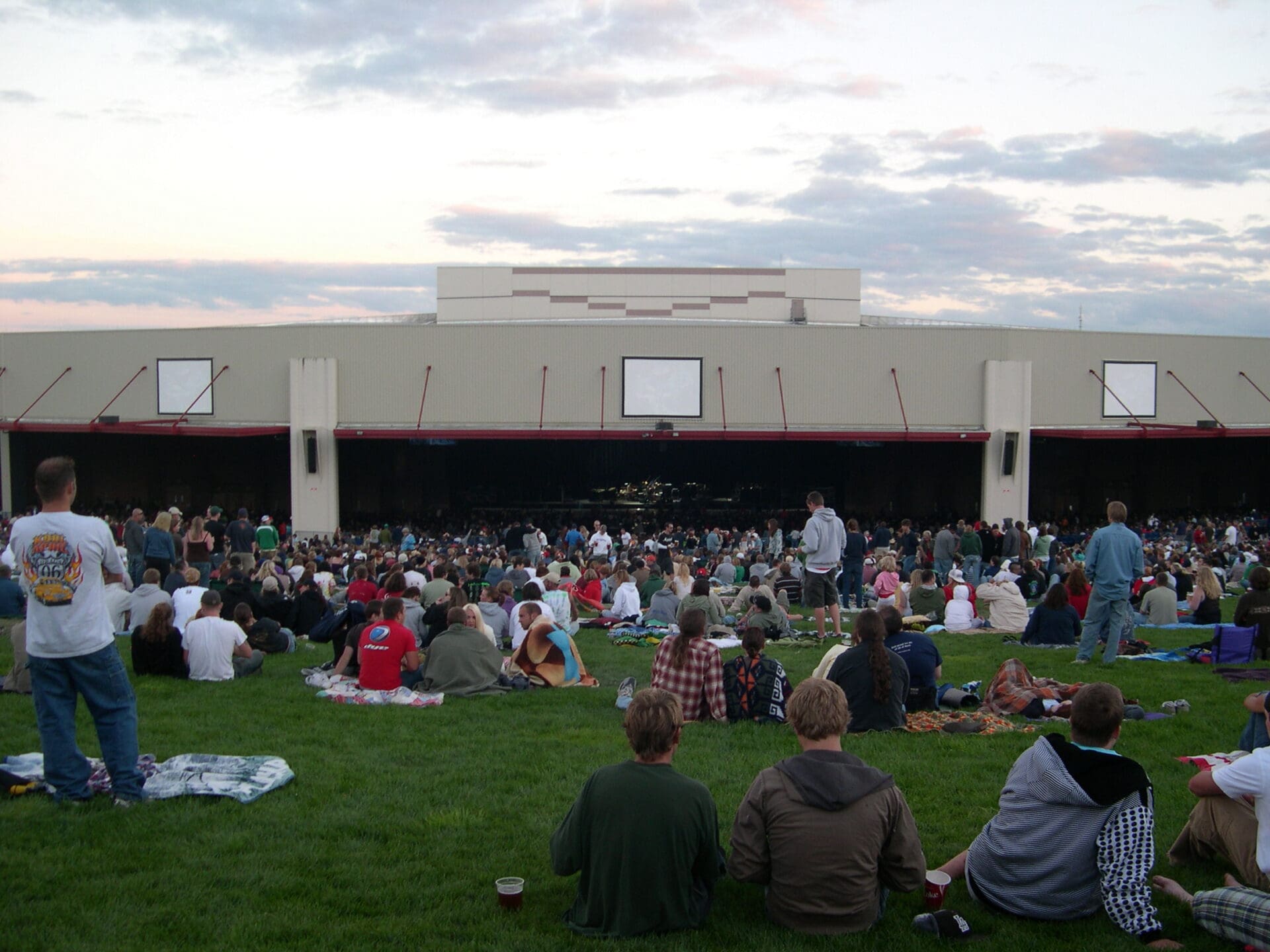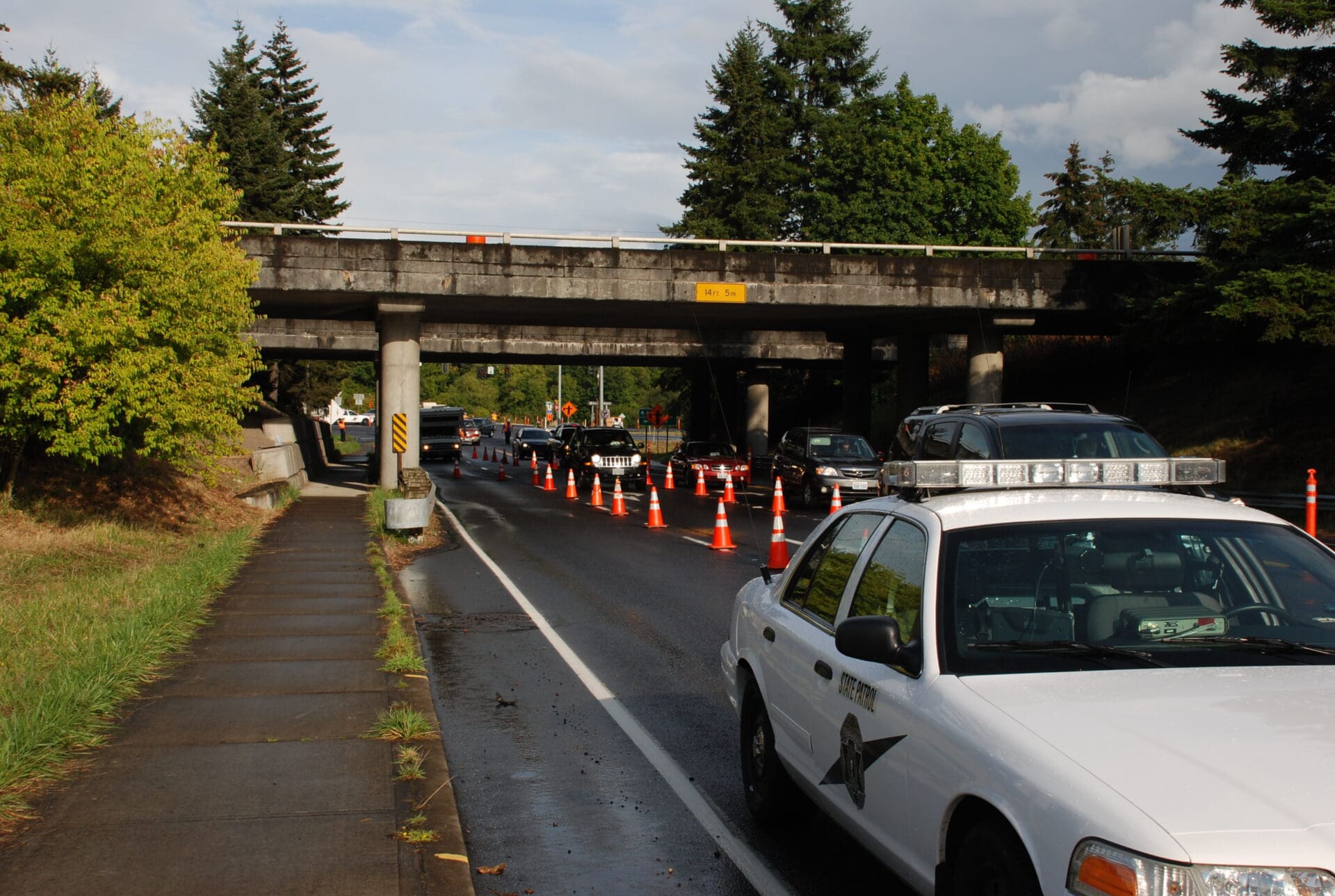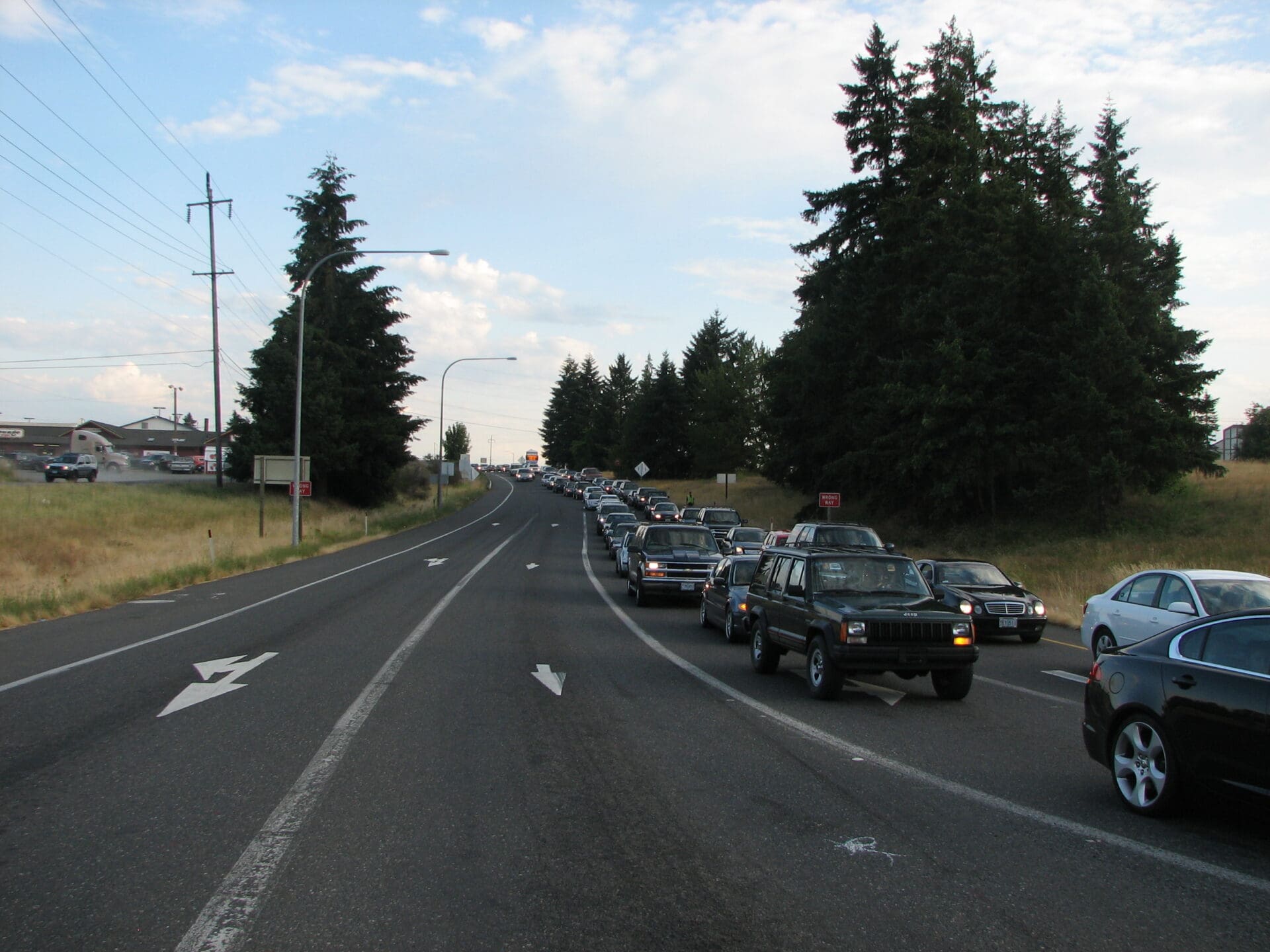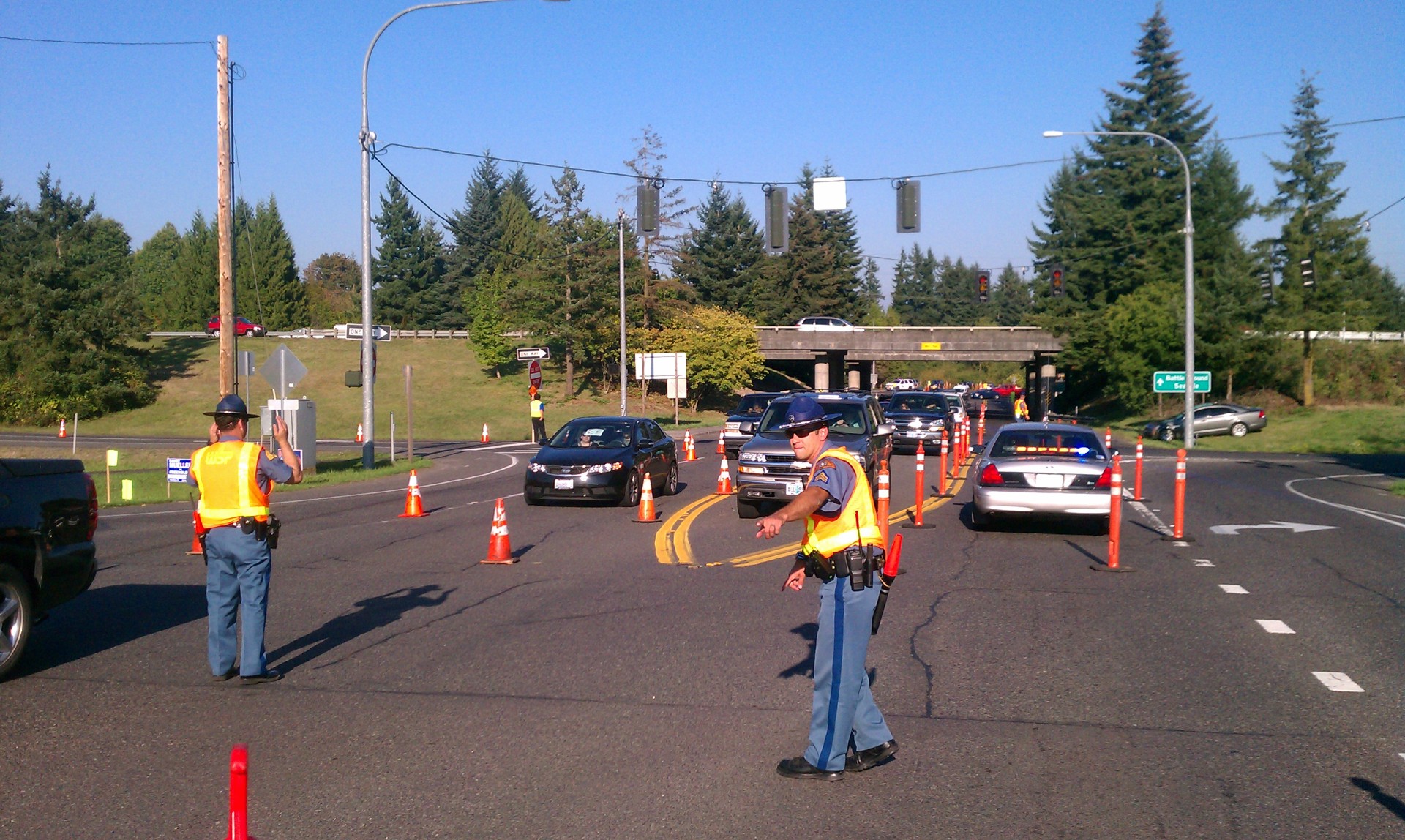October 22, 2025
With largely rural surroundings, unincorporated Clark County, Washington isn’t typically your most congested place. That is, unless the Cascades Amphitheater is hosting a concert, drawing thousands to a nexus of intersections designed for far fewer.
The amphitheater was founded in 2003, and since then, it has undergone six name changes, hosted hundreds of musicians, held annual graduation ceremonies, and implemented countless traffic control methods to help accommodate the high demand. It’s also the site of Kittelson’s first large-scale traffic control project and longest-running project. Our longstanding partnership with the amphitheater and adjacent relationships with Clark County and the Washington Department of Transportation (WSDOT) offer a look into how traffic strategies grow and adapt in the long term.

Since the amphitheater opened in 2003, it’s been a go-to venue for big-time artists, including Aerosmith, the Backstreet Boys, Coldplay, Fleetwood Mac, Jimmy Buffet, Pearl Jam, and ZZ Top. Photo source: Kittelson & Associates, Inc.
As the cause of occasional influxes of traffic in a rural and residential area, the amphitheater was required to prepare a conditional use permit before opening. The amphitheater (known in 2003 simply as the Clark County Amphitheater) brought Kittelson on board to develop a comprehensive traffic management strategy that would address unique traffic flow conditions during both weekday and weekend event days.
Kittelson’s efforts began with extensive data collection that ultimately led to predictive traffic models and the development of traffic control plan (TCP) alternatives for varying event sizes, vehicle occupancies, and travel demand and trip distribution. Over many years, we cultivated connections with WSDOT, Washington State Patrol (WSP), traffic control officers from Oregon and Washington, and the Clark County Sheriff’s Office (CCSO) to provide coordinated support for each event—and the region beyond.

Successful event management depended on coordination with the Washington State Patrol, which often provided manual traffic control services. Photo source: Kittelson & Associates, Inc.
Looking back through the amphitheater’s evolution, what strategies did we use to manage traffic for events of varying size and impact? And how did we build out these strategies over time as the region grew and changed? Let’s find out.
Constructing a Toolbox for the Years to Come
The 2003 TCP built a foundation for lasting success, focusing on three major areas: signalized and manual traffic control, detours, and trip consolidation programs. These early techniques represent our alignment with the amphitheater on the most fundamental of transportation values: we wanted people to be able to access their destination safely and efficiently, even in exceptional traffic circumstances.
Intersection Control
Picture this: thousands of cars swarming into a small cluster of intersections and two-lane roads to get to the latest show. Much of this traffic comes northbound on the I-5, all of which must turn left from the offramp onto westbound 179th Street to make what should be a short jaunt to the amphitheater. During larger events, traffic can get so congested that cars are in stop-and-go traffic from the freeway offramp onward.

A queue of cars heading to the amphitheater. Photo source: Kittelson & Associates, Inc.
This level of peak demand called for two methods of control as mitigation strategies: signalized and manual. We revised signal timing at this and other key intersections to provide prioritized progression toward the amphitheater during periods of ingress. But at peak hours for larger events, the area needed more than specialized signal timing plans. To accommodate such supersized demand, we implemented full manual control (turning off all traffic signals) to help facilitate throughput. Full manual control often required WSP and CCSO officers to manually direct traffic through intersections. Traffic coning, reverse-flow strategies, and manually controlled two-phase systems were put in place ahead of the event to ease the transition from signalized to manual and back again.
Manual control was also essential when experimenting with different ways to funnel cars through the main entrance and fill and vacate parking lots. Technology can do a lot, but sometimes people are the most effective and reliable way to help out overwhelmed drivers.
Detours
Managing crowded intersections is best combined with strategies to decrease those crowds in the first place. Enter detours. As part of the conditional use permit approval, the TCPs established two detour strategies: active and passive. Active detours reroute non-concert goers onto side streets so they can avoid passing through amphitheater traffic. Passive detours use signage to inform drivers ahead of time that they have the option to take advantage of alternate routes.
Each strategy gives travelers and local residents who are not headed to the amphitheater an opportunity to skirt around the major jams. Rerouting local traffic also keeps event attendees consolidated on one route that can be strategically managed.
Adapting traffic routes within the venue itself, too, was another strategy we tried out. We turned the spine road within the venue into a temporary one-way, freeing up an extra lane of space for cars entering or exiting, depending on the time.
Trip Consolidation Programs
Another core way to lessen crowds is to consolidate passengers in fewer vehicles. For the amphitheater, we helped develop and implement programs that encouraged people to choose options other than single-occupancy vehicles. In 2003, the Your Enhancement of Service (YES) program was launched to encourage carpooling. YES gave vehicles with three or more patrons—raised to four or more the following year—access to more convenient parking and priority when departing parking lots.
In 2004, the amphitheater partnered with Coast2Coast event services to provide direct transit service from Portland and Vancouver to the amphitheater. The shuttles took detour routes to avoid getting stuck in tricky intersections, incentivizing transit use and alleviating strain on roadway capacity.
Contraflow auxiliary lanes—extra transit lanes that go against the flow of traffic—further helped give the shuttles an edge over vehicle traffic. Each of these early programs saw continued long-term adoption, exemplifying how a thorough approach from the get-go can establish consistent services that patrons rely on.
Learning from Data and Adjusting TCPs
As our partnership with the amphitheater continued, we saw our work at the venue not only as a chance to implement a suite of primary techniques, but as an opportunity to study and refine them. Since 2003, we had been taking volume counts from each event and from base conditions in the area to best predict traffic control needs. This ongoing recordkeeping shaped our annual updates to the TCP.
Factors such as non-event-related traffic conditions, arrival rate, trip distributions, vehicle occupancy, and transit ridership vary event by event, meaning that the projected attendance number isn’t always an accurate gauge of traffic. An event with 8,000 patrons can create similar traffic patterns to a 5,000-patron event, depending on how spread out the arrival rate is, how high vehicle occupancy is, and how many patrons take transit.
This multifaceted analysis doesn’t just inform traffic efficiencies—it also influences what time events occur. In 2005, we conducted an early-start-time and late-start-time sensitivity analysis to understand the impacts of shifting peak arrival times on weeknights, when interactions with existing commuter traffic could result in increased traffic pressure. We created a matrix based on past data, corridor capacity, and projected event size to estimate the optimal start time for a weekday event, with smaller events starting earlier and larger events starting later.
Tracking impacts on traffic volumes and queue times is also key for measuring success and knowing when to adjust management strategies. Over hundreds of events, we worked with the amphitheater to explore the addition, removal, and relocation of signs, barricades, officers, flaggers, and cones to find the ideal configurations for each event. For each year’s event season, in collaboration with WSDOT and with Clark County’s review and approval, an updated and modified TCP was produced to apply the lessons learned, pilot new strategies, and ensure renewal of conditional use permits.
Let’s zoom in to 2010, for instance. The updated TCP permitted movements that had previously been diverted to allow for better free flow of non-amphitheater traffic and reduce traffic impacts on local neighborhoods. This one change entailed the removal of 18 outdated signs, the addition of 13 signs, the elimination of manual control at one signalized intersection, and the relocation of three flaggers, showing the rippling reach of each adjustment and the continued evolution of TCPs.

Even with all the technology at our disposal, humans are sometimes still the most effective traffic control devices. Here, officers help manage congestion by directing vehicles through an intersection near the amphitheater. Photo source: Kittelson & Associates, Inc.
Spreading the News
Some broader informational updates to the TCP were essential for pairing with these smaller, more precise tweaks. So, in 2009, we created a Public Announcement Strategies Report that outlined measures for spreading information tailored to residents, commuters, and patrons. We built this report from a different kind of data taking: the qualitative assessment of feedback on congestion and delays. The report raised public awareness of events and their associated traffic control measures.
From there, we moved full steam ahead into a communications strategy. The new TCP involved variable road message signs, local media releases, and webpage postings to share expected levels of congestion, detour routes, traffic circulation schematics, and parking info. We even took advantage of existing video monitors at the venue to display real-time information on egress circulation and parking clear out timing estimates.
Balancing quantitative data with the kind of qualitative assessments that shaped our public announcement strategy helped our traffic control be as in tune with the needs of the area as possible. Well-rounded learning creates well-rounded approaches—and improves transportation experiences for everyone involved.
Changing Infrastructure in a Growing Region
Over time, as the featured artists changed from Tom Petty to Maroon 5 to Pitbull, the area’s infrastructure changed and evolved with regional growth, too. Our work with the amphitheater extended beyond local traffic control. From lane additions to street improvements to entire interchanges, we tracked major projects in the Southwest Washington region to provide support and understand how they would affect traffic during construction and after completion.
These efforts expanded the scope of our original traffic management strategies. In the early days, we were working with what pertained directly to the amphitheater and direct access alternatives; later, we tuned in to a wider range of agencies and projects of regional impact to understand how the amphitheater fits in the bigger traffic puzzle.
The Salmon Creek Interchange Project—one of the biggest public works projects in Clark County history and one of the largest infrastructure improvements in the region—extended the 139th Street interchange across the I-5 and I-205, alleviating pressure on 134th Street, which was previously the only major east-west arterial in the area. The interchange created highway connectivity to the south that hadn’t existed before. This new connectivity was pivotal for the region, which had been rapidly growing since the addition of a Washington State University campus, but also for the amphitheater and the surrounding community. The interchange further alleviated traffic around the venue by providing a primary alternative route for residents.
Another interchange, completed in the late 2000s at I-5/219th Street, further accommodated the growing region by diverting traffic from that hairy I-5 and 179th Street interchange. All this additional roadway capacity provided better options for the community moving in and out of the area and helped streamline event traffic.
Changes in infrastructure also took place at the amphitheater itself. In 2008, the amphitheater widened its driveway entrance to allow smoother turning movements. Along with the redesigned driveway, improvements to parking lot paving infrastructure helped streamline traffic in and out of the venue.
Taking Traffic Control into the Future
The strategies explored at the amphitheater model a range of traffic control ideas that can be applied to many large event venues across the country, from concert venues to sports stadiums to conferences and conventions. Think big: as Los Angeles gears up to host the 2028 Olympics, some of these same strategies—like two-way to one-way street conversions, reversible lanes, temporary auxiliary lanes, transit priority lanes, and signal timing adjustments to benefit the dominant flow of traffic—could be considered, just on a much larger scale, throughout the city’s major routes to and from sites of the games.
App-based ridesharing, travel time optimization, and other technology continues to evolve in leaps and bounds far beyond what we were working with back in 2003. Yet, the power of manually directing traffic in highly variable circumstances continues to be relevant.
Today, thanks to twenty years of collaboration and partnership, the amphitheater has many effective methods to choose from as it tailors traffic control to each event’s needs. Continued regional growth and local infrastructure changes demand a nimble and responsive traffic plan, and in the future, as technology improves or when more cones are needed on the ground, we will be ready to help.
